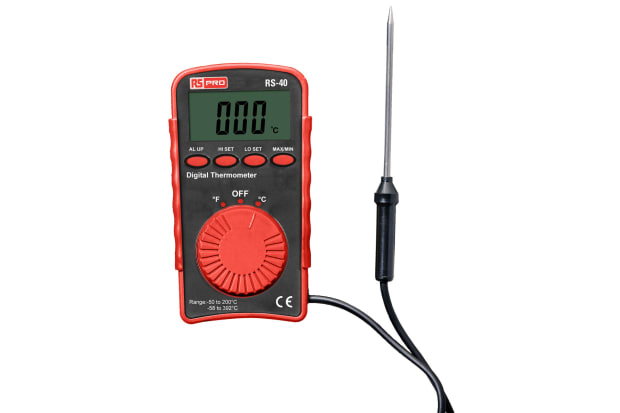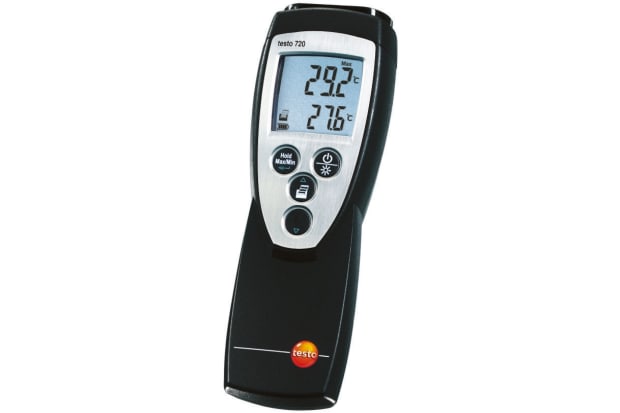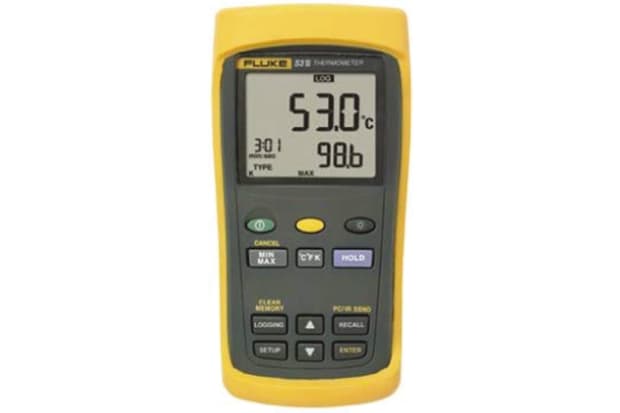- Published 11 Jan 2023
- Last Modified 29 Aug 2023
- 11 min
The Complete Guide to Digital Thermometers

What is a digital thermometer?

The digital thermometer is a widely used item of temperature-measuring equipment that significantly overhauls and updates the traditional liquid-based thermometers of yesteryear.
The classic liquid mercury thermometer was first popularised through 17th- and 18th-century developments in the field of clinical science, and remained fundamentally unchanged as our go-to temperature-reading device right up until the invention of commercially viable thermistors in the 1930s. By that point, the core elements of basic thermography had already been broadly understood for many hundreds of years - arguably thousands, if we include the early observations of Ancient Greek scholars with their crude tubes of water and air.

However, modern digital thermometers and probes work on different (albeit related) thermographic principles. They deliver a number of key advantages over the old liquid-in-glass versions, making digital thermometers infinitely better suited to all manner of uses across a broad range of 21st century industries and applications.
In this guide, we’ll explore exactly what digital thermometers do, what sorts of environments they’re best adapted to, and some of the many different varieties that are available on the market for home and workplace use today.
How does a digital thermometer work?

How a digital thermometer works There are various different kinds of modern digital thermometer sensors, among the most common of which is a type called a ‘resistance temperature detector’ (RTD). This sort of thermometer works on the principle that the electrical resistance of metal changes with temperature.
Other digital thermometer sensor types include thermocouples and thermistors - these are both immediately recognisable as variants of digital thermometers with probes, although each type relies on related but distinct laws of thermodynamics for operation

An RTD sensing element is effectively a subtype of thermistor. They’re built to include electrodes made from various types of suitable metals in a probe-style tip, each of which has a stable, repeatable and measurable resistance-versus-temperature relationship.
When an electrical voltage from a power source (often a simple battery in modern portable devices) is passed through these electrodes, the resistance it encounters is impacted by how warm or cool the metals are.
By measuring the resulting current flowing between electrodes of a specific metal (often platinum, but copper or nickel are also viable, if less versatile, options), an on-board chip can then convert this value into an extremely accurate reading of precise temperature at the element, and display it numerically on a screen. This is very commonly housed on the body of the tool itself, as seen in most LCD digital thermometers.
What are digital thermometers used for?
Digital thermometers offer an extremely wide range of uses in day-to-day professional and home applications. They provide accuracy and speed of temperature reading in almost any situation that a traditional thermometer would do, as well as being ideally suited to a great many scenarios in which liquid-in-glass versions would be unsuitable.
In most applications or environments that would prove challenging to a liquid thermometer, there will be a digital version available that can perform the task without issue. This include:
Scenarios in which the accuracy of a traditional thermometer is likely to be compromised or insufficient.
Situations in which quick, highly responsive temperature readings need to be taken repeatedly across different zones or surfaces, without having to wait for liquid versions to ramp up or return to neutral.
Environments that are likely to cause damage to or failure of more fragile glass thermometers.

With digital thermometers specifically, it’s important to note that the right kind of product has to be chosen for the task at hand. While some brands and designs are intended as multi-use probes, certain configurations of digital thermometer are explicitly aimed at use in measuring food temperatures, for example, while other varieties might be made exclusively for taking body temperature readings in a clinical setting.
Common uses of digital thermometers across a broad range of industries and sectors today might include:
Medical applications
Food production and preparation
Meteorological instruments
HVAC thermometers
Laboratory environments
Home use
Over the coming sections, we’ll look more closely at some of the more common usage techniques and different types of digital thermometers.
When may a digital thermometer be used?
In determining the correct environments and applications for use of specific types of digital thermometer, the following sorts of considerations should be taken into account:
Operating range
This is the range of temperatures that a given thermometer will be constructed and calibrated to work properly within, and is among the most important factors in selecting a product of this type with an intended use in mind.
Hygiene and sanitation
Products intended for use in food production and preparation, medical or laboratory settings may need to be manufactured to provide easy sanitisation options, which not all models are explicitly designed for.
Waterproofing and dustproofing
Various models and brands of digital thermometers may come with different IP ratings for protection against ingress from moisture, solid particulates, inclement weather or other potential hazards to sensitive electronic equipment.
Rigidity, shatter-resistance and explosion-proofing
Some industrial types of thermometer are more ruggedly constructed than others; many are designed to be non-sparking in the event of electrical or gas combustion within or near the device, to reduce risk of a chain reaction in the surrounding environment.
Size, weight and portability
This also a valuable consideration if the device needs to be carried around between work sites regularly, and available for use at short notice; many digital thermometers are extremely portable, but some of the more robust and engineered varieties are less convenient for all-day carrying than the common pocket digital thermometers.

Food probe digital thermometers
To ensure thorough and even cooking, food probe thermometers need to be accurate, and to offer quickly repeatable temperature readings in multiple different areas of food undergoing production or preparation. They must be hygienic and easily sanitised between uses to prevent bacteria build-up or transfer, and often include colour-coding options to help with this.
Most food probe digital thermometers will be designed to be inserted directly into the food item in question, although unlike many analogue thermometers, they’re very seldom designed to be left in food during cooking. Different types of thermometer may be better suited to solid, liquid or frozen foods.
Other types of food probe thermometers include ‘between pack’ probes, engineered to slip between stacked crates or boxes of food items in storage, and air probes intended for taking ambient temperature readings in cold storage areas.

Industrial digital thermometers
Products intended for industrial use tend to be more ruggedly constructed and suitable for use in a range of potentially challenging or hazardous environments. They may be designed to fit with multiple different probe types, including thermistors and thermocouples, and will often include additional features such as countdown timers, rubberised IP-rated housings, backlit displays and non-sparking material constructions.
Common applications for industrial digital thermometers include HACCP environments, heat and hot water system testing, air conditioning and ventilation, refrigeration, manufacturing, and measurement of organic or oxidising surfaces.

Central heating and HVAC digital thermometers
HVAC and central heating applications are one of the most common industrial and engineering environments in which digital thermometers are routinely used. HVAC digital thermometers are most commonly used to measure air, water, copper line and refrigerant temperatures, and must be extremely accurate as a single degree change can lead to compliance failures or equipment damage.
Common applications for industrial digital thermometers include HACCP environments, heat and hot water system testing, air conditioning and ventilation, refrigeration, manufacturing, and measurement of organic or oxidising surfaces.
Ideal choices for HVAC applications may include additional features such as attachment magnets, extended or remote sensor probes, and even infrared sensors for use in areas that are otherwise out of easy reach.

Scientific digital thermometers
A scientific digital thermometer can play an extremely important role in all kinds of laboratory-based testing, experimentation, or product research and development.
They may form a crucial part of an incubator setup, for example, or be critical for fast and ultra-accurate readings across a very wide range of temperatures during product safety testing. In clinical trials, they might often need to be fully IP-rated for use in water baths, heating blocks and incubators, or able to run unattended for extended periods while logging or recording data.
Various sorts of scientific digital thermometers will include special features such as maximum and minimum temperature logging, on-board alarm systems, multiple readout displays or especially robust chemical and acid resistance.
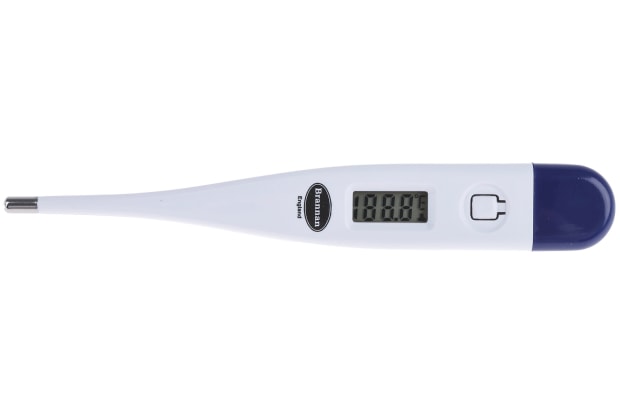
Medical digital thermometers
Medical digital thermometers generally need to be extremely hygienic and easy to sanitise, for obvious reasons. They also tend to be relatively portable, as they’ll frequently need to be carried around from site to site, and yet accuracy and speed of readout are often critical.
Many medical digital thermometers include combination probe types, which makes them usable for various different methods of body temperature reading other than the standard oral digital thermometer type. These are often removable and interchangeable for additional hygiene and ease of cleaning.
Handheld digital thermometers - especially those intended for use in the medical field - typically exhibit lightweight ergonomic designs for repeated all-day use, and often boast extra features such as pulse and respiration timers. Some medical needs are also ideally suited to infrared varieties of digital thermometers for non-contact and non-invasive applications.
Types of digital thermometers
As we’ve seen in the above sections, there are many different designs, brands, probe types and additional features available across the range of digital thermometers sold today. In this section, we’ll briefly list some of the more commonly found configurations and designs.
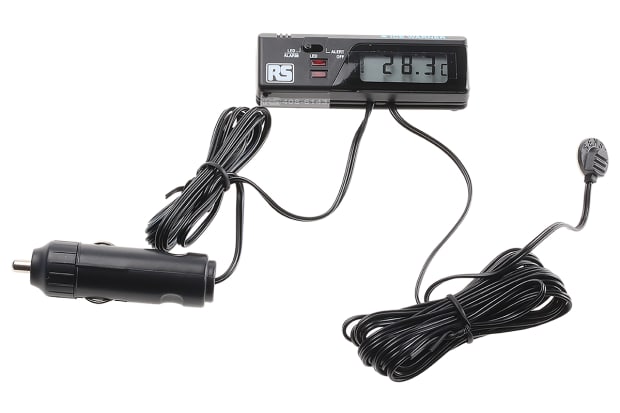
Digital thermometers for cars and autos
Digital thermometers for cars are increasingly common accessories used for reading both internal and external temperatures of individual components or areas within the vehicle. This might include the operating temperature of air conditioning systems, or outside ambient temperatures in harsh weather.
In-car digital thermometers often feature weatherproof sensors for the outside of the vehicle and can be powered either by an internal battery or via the car’s 12V socket on the centre console.
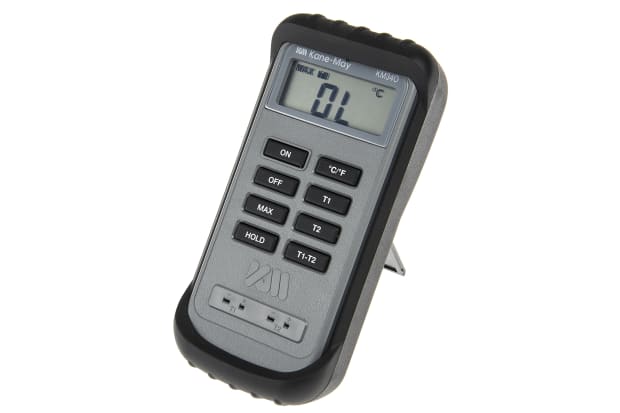
Differential digital thermometers
As the name implies, a differential digital thermometer is a product specifically designed for measuring the difference in temperature between two zones, components or surfaces by using two probes simultaneously.
This is often very useful in a range of HVAC and other engineering or industrial applications, such as radiator balancing in heating systems, and can sometimes come with various additional components such as oscillators, lock-in amplifiers or calorimeters for an increased range of functionality. Differential thermometers are commonly intended for use with K-type thermocouple sensors.

Wall-mounted digital thermometers
Some designs of digital thermometers are wall-mounted by design, principally for space-saving purposes and ease of reading when in hands-free use. This type tends to be better suited to taking ambient readings of environmental temperatures, although highly accurate probe-type configurations are also available as wall-mounted digital thermometers for use in HACCP self-monitoring applications.
These are often supplied with longer cabling runs between probes and display screens, to enable temperature-critical monitoring of liquids, air, refrigerated foodstuffs and semi-solids at distance from the readout module.

Wireless digital thermometers
Wireless digital thermometers can be extremely useful when monitoring and logging accurate temperatures over larger areas, or between multi-member work teams with numerous temperature-measuring devices spread across a wider zone.
For industrial and worksite purposes, many wireless temperature-reading setups come in modular, multi-handset configurations that are able to communicate remotely with one another to gain an overall picture of temperature shift, as well as to feed data back to a central logging and processing unit for quick and convenient collation of results.
In domestic use, wireless or Bluetooth digital thermometers simply offer an additional level of convenience and safety in allowing remote monitoring of food temperatures, in-car components, weather conditions and more, often while including the option to send collected data back to a smartphone, tablet, PC or other remote-viewing devices.
Summary
Digital thermometers offer a very broad selection of potential uses in both home, workplace and industrial settings. There are many product options available on the market today that are designed principally to provide an additional level of speed and convenience in common everyday uses around the home.
Meanwhile, a huge variety of more specialised digital thermometers are manufactured to extremely exacting standards of performance and resilience, and aimed more directly at achieving incredibly accurate readings across a wide range of temperature-critical operations in some of the most challenging and hazardous workplace applications.
Related links
- What is the Liquid in Glass Thermometers and How Do They Work?
- A Comprehensive Guide to Infrared Thermometers
- Brannan 11/064/2 Wired Digital Thermometer for Medical Use +42.9°C Max
- What are Temperature Probes?
- How to Calibrate a Thermometer
- Digital Multimeters and How to Use Them
- What is a Clamp Meter & How Do You Use One?
- A Complete Guide to Tachometers
